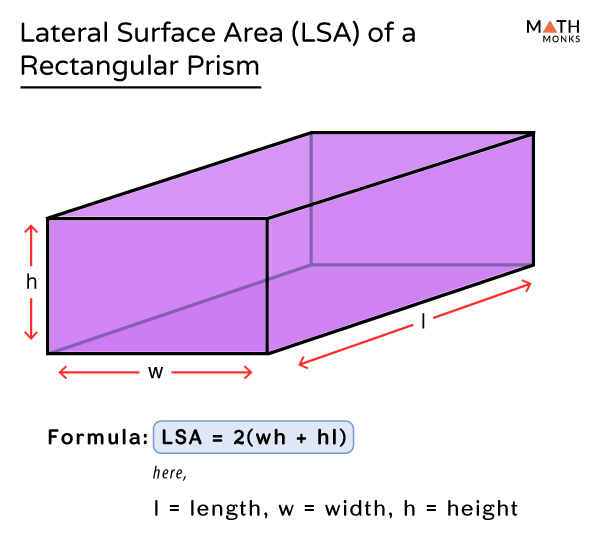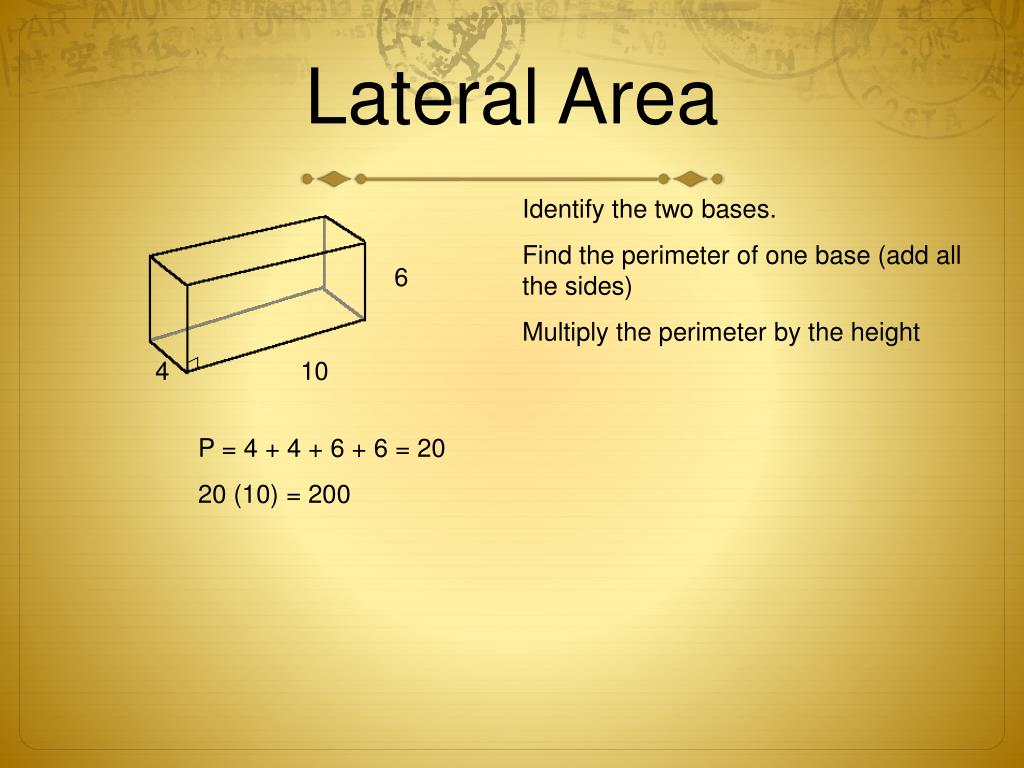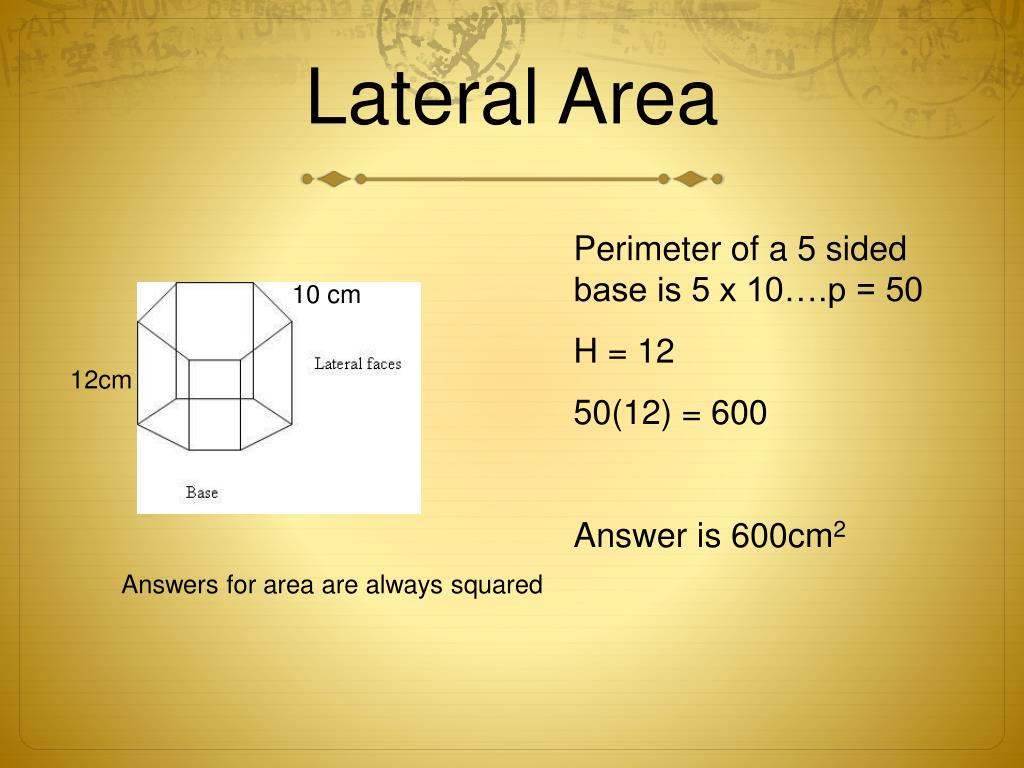What Is The Lateral Area Of The Drawing, A rectangular pyramid has 5 faces, a rectangular base and 4 triangular lateral faces.
What Is The Lateral Area Of The Drawing - Web plug in your numbers to solve for ae. 10 * 4 = 40 mi². Web the lateral surface area is the surface area of the sides of any three dimensional figure. In this article, the lateral surface area of different figures including cuboid, cube, cylinder, cone, and sphere. The lateral area of the prism is 294 m². Search for an answer or ask weegy. It is also called lateral surface area (lsa) or curved surface area (csa) of a cone. As you can see the shape has all four lateral faces of the same rectangular form with the same sides lengths, therefore, answer: For a cube the lateral surface area would be the area of the four sides. Web it follows from the pythagorean theorem that the leg common to both right triangles (the altitude of the equilateral triangle) is s*sqrt(3)/2. Web the total surface area of the cylinder formula is the sum of the base surface area and the lateral surface area: The area of the lateral face that is rectangle with sides 5 mi and 2 mi is. Web the lateral surface area is the surface area of the sides of any three dimensional figure. (7 m)² = 49. Log in for more information. This is the height of each trapezoid. Search for an answer or ask weegy. Side is the side length of the pentagon. Web the lateral area formula is used to find the lateral area of any solid object. Lsa = 2πr*h, where r is the. It is also called lateral surface area (lsa) or curved surface area (csa) of a cone. Each of the 6 faces is a square 7 m on the edge. Web the lateral surface area is the area of the lateral surface. As you can see the shape has all four lateral faces of. Side is the side length of the pentagon. So the equilateral triangle's area is (1/2)s*s*sqrt(3)/2 = s^2*sqrt(3)/4. Perpendicular is the perpendicular height of the pentagon. Area rectangle = w * l. 5 * 2 = 10 mi² (area 1 rectangle) then you multiply by 4. In the case of a can of beans, the label that wraps around the can represents this lateral surface area. To find the lateral surface area of the can, we need to use the formula for the lateral surface area of a cylinder: In this case, based on the provided information, the drawing is of the greater wings of sphenoid. Then use your formula for the area of a trapezoid, (b1+b2)h/2, to get the area of each side, then multiply by 4 to get the lateral area since there are 4 sides. Web the lateral surface area of a cone. Here we have a base of 5mi*5mi and a height of 2 mi. (7 m)² = 49 m². Lsa =. The important dimensions of the cone are the height h, the radius r and the slant height s,. Side is the side length of the pentagon. The total surface area is the area of all the faces, and the lateral surface area leaves out the base. For a cube the lateral surface area would be the area of the four. 5 * 2 * 4 = 40 mi². The total surface area is the area of all the faces, and the lateral surface area leaves out the base. Web the total surface area of the cylinder formula is the sum of the base surface area and the lateral surface area: Web the lateral surface area of a cone is given. The area of the lateral face that is rectangle with sides 5 mi and 2 mi is. The lateral area of the prism is 294 m². Area rectangle = w * l. Web the lateral area of the shape is the sum of the area of all lateral faces. Web the lateral surface area of an object is equal to. If we want to calculate the lateral area, we only need to calculate the area of the 4 lateral sides (the lateral sides are all of those that aren't the bottom of the top) we know that the area of a rectangle is the product of its sides, then, in this case, each of the lateral. It is also called. Each of the 6 faces is a square 7 m on the edge. Web the lateral surface area of a cylinder is the area of the sides of the cylinder, not including the top or bottom. Web the lateral surface area is the surface area of the sides of any three dimensional figure. What is the surface area of the rectangular prism? The area of the lateral face that is rectangle with sides 5 mi and 2 mi is. In the case of a can of beans, the label that wraps around the can represents this lateral surface area. Lsa = 2πr*h, where r is the. To find the lateral surface area of the can, we need to use the formula for the lateral surface area of a cylinder: It can be calculated using the following formula: The lateral area of the prism is 294 m². The lateral area is also referred to as the lateral surface area (lsa) and. Each figure may have a different base, but the lateral surface area is found the same. The purpose here is to explain the standard formula for the lateral (upper) area of a standard right circular cone. 10 * 4 = 40 mi². For a cube the lateral surface area would be the area of the four sides. The total surface area is the area of all the faces, and the lateral surface area leaves out the base.
How To Find Lateral Area Of Triangular Prism Haiper

Lateral Area Rectangular Prism Formula

what is the lateral area of the drawing

Surface Area of a Rectangular Prism Formulas, Examples, & Diagrams

use formulas to find the lateral area and surface area of the given

Lateral Area Definition, Formula & Examples Video & Lesson

Lateral Area Formula What Is Lateral Area Formula? Formula

Lateral Area of a Square Pyramid Formula, Examples, Definition

PPT Lateral Area, Surface Area, and Volume Notes PowerPoint

PPT Lateral Area, Surface Area, and Volume Notes PowerPoint
Lateral Area = 5 * Side * Perpendicular / 2.
They Are 4 Equal Rectangle.
The Lateral Area Differs From The Surface Area Of A Geometric Solid By The Subtraction Of The.
A_L = Π X R X L.
Related Post: